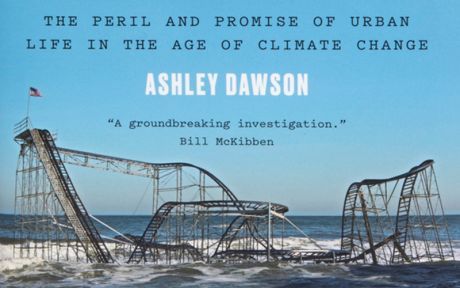Features
You are here
Review: Extreme Cities: The peril and promise of urban life in the age of climate change by Ashley Dawson

November 19, 2018
Ashley Dawson’s use of the term “extreme” in the title of his book refers to “… an urban space of stark economic inequality, the defining urban characteristic of our time, and one of the greatest threats to the sustainability of urban existence.”
Urbanization has been continually growing for decades, so that now “…the majority of the world’s megacities are in coastal zones threatened by sea level rise. Today, more than 50 per cent of the world’s population lives within 120 miles of the sea.” Cities are where carbon emissions from industries and transportation are highest.
By focussing on extreme cities that are located at sea level, he carefully documents how climate change will negatively affect huge populations of people, many of whom are poor and least able to cope with the impact. Recall the deaths and forced relocations of low-income black people in New Orleans after Hurricane Katrina and you get the beginnings of the picture.
The book pays particular attention to Miami, New York (to remind American readers, as if they needed reminding, that rising seas won’t just be affecting remote Pacific islands), Jakarta, Delhi, Port-au-Prince and Sao Paulo. In Canada we can add places like Montreal (which saw record heat wave-related deaths this past summer, as well as a huge upsurge in climate justice activism on the streets), Richmond, BC, Halifax and other coastal cities to the mix; say good-bye to the scenic Vancouver airport.
Drawing from earlier work by Mike Davis, particularly Davis’ Planet of the Slums, Dawson reminds us of how capitalism has thrown millions of peasants world-wide out of their traditional farming and into a poverty-laden urban proletariat or unemployment. While on Turtle Island/North America, much of our climate justice opposition has been led by indigenous communities threatened by pipeline or marine spills, it is also the case that “extreme cities” will see huge numbers of people threatened.
In addition to highlighting the physical, social and economic disasters awaiting the residents of extreme cities, Dawson lists what needs to be done to ensure a just transition. There needs to be a planned relocation of populations, so that the poor are not left behind. Otherwise what we are likely to see under capitalism is the wealthy able to make their getaway, leaving everyone else stranded.
Using an anti-capitalist analysis, Dawson also points the ways forward for achieving a just and democratic way out of the impending climate disaster, especially in extreme cities. His chapter entitled “Disaster Communism” describes the grass-roots community response to Super Hurricane Sandy in New York in 2012. He notes that grass-roots efforts by health and social service workers, and other community organizers, were quicker and more efficient than state and federal government departments. “Rather than provoking selfish, antisocial, and even belligerent circumstances, most people tend to regain their self-control and become concerned about the conditions of those around them relatively quickly.”
Dawson argues that continuing climate disaster will likely make “disaster communism” more common and, like Andreas Malm, points to the origins of some of the Arab Spring uprisings in climate-induced droughts, leading to higher food prices and resulting grain riots.
But he has no illusions in “horizontal” organizing as the ultimate solution. He states “Disaster communism – on a purely local scale- does not actually constitute an inherent threat to the capitalist social order.” He backs this up by describing how quickly state bureaucracies and elite interests intervened post-Hurricane Sandy to resume control of rescue and reconstruction operations.
Unfortunately, Dawson has no suggestions for how the required changes he recommends can come about aside from a general call for social movements to act in unity. He is deafeningly silent on the role of the working class, which is odd given his quotes throughout the text of figures like Trotsky and modern day Marxists like David Harvey and Mike Davis.
In spite of this significant shortcoming, the book is still recommended. We should be inspired by his conclusion that “The good city cannot be a version of today’s city newly embellished with green trimmings like bike lanes and ribbon parks in front of high-end condos. The good city will only heal the wounds of calamitous environmental degradation if it is rebuilt to overcome today’s yawing economic and social inequalities.”
Section:










